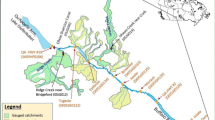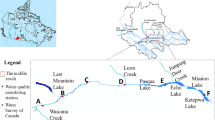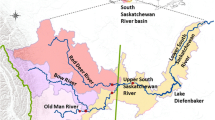Abstract
Knowledge of water quality conditions is essential in assessing the health of riverine ecosystems. The goal of this study is to determine the degree to which water quality variables are related to precipitation and air temperature conditions for a segment of the Pearl River Basin near Bogalusa, LA, USA. The AQUATOX ecological fate simulation model is used to estimate daily total nitrogen, total phosphorus, and dissolved oxygen concentrations over a 2-year period. Daily modeled output for each variable was calibrated against reliably measured data to assess the accuracy. Observed data were plotted against simulated data for controlled and perturbed models for validation, and stepwise multiple regression analysis was used to quantify the relationships between the water quality and meteorological variables. Results suggest that daily dissolved oxygen is significantly negatively correlated to concurrent daily mean air temperature with a total explained variance of 0.679 (p < 0.01), and monthly dissolved oxygen is significantly negatively correlated to monthly mean air temperature with a total explained variance of 0.567 (p < 0.01). Total mean monthly phosphorus concentration is significantly positively related to the previous month's precipitation with a total explained variance of 0.302 (p < 0.01). These relationships suggest that atmospheric conditions have a strong influence on water quality in the Pearl Basin. Therefore, environmental planners should expect that future climatic changes are likely to alter water quality.







Similar content being viewed by others
References
Bourgeois-Calvin, A., Briuglio, S., Rheams, A., & Dufrechou, C. (2004). Pollution source tracking in sub-watersheds of the Lake Pontchartrain Basin, Louisiana. Proceedings of the Water Environment Federation, 2004, 182–199.
Bricker, S. B., Longstaff, B., Dennison, W., Jones, A., Boicourt, K., Wicks, C., et al. (2008). Effects of nutrient enrichment in the nation's estuaries: a decade of change. Harmful Algae, 8(1), 21–32. doi:10.1016/j.hal.2008.08.028.
Carleton, J., Park, R., & Clough, J. (2009). Ecosystem modeling applied to nutrient criteria development in rivers. Environmental Management, 44(3), 485–492. doi:10.1007/s00267-009-9344-2.
Carvalho, L., Miller, C., Spears, B., Gunn, I., Bennion, H., Kirika, A., et al. (2012). Water quality of Loch Leven: responses to enrichment, restoration and climate change. Hydrobiologia, 681(1), 35–47. doi:10.1007/s10750-011-0923-x.
Chapra, S. (2003). Engineering water quality models and TMDLs. Journal of Water Resources Planning and Management, 129(4), 247–256.
Chapra, S., Pelletier, G., & Tao, H. (2007). QUAL2K: a modeling framework for simulating river and stream water quality, version 2.07: documentation and user's manual. Medford: Tufts University.
Delpla, I., Jung, A. V., Baures, E., Clement, M., & Thomas, O. (2009). Impacts of climate change on surface water quality in relation to drinking water production. Environment International, 35(8), 1225–1233. doi:10.1016/j.envint.2009.07.001.
Göncü, S., & Albek, E. (2010). Modeling climate change effects on streams and reservoirs with HSPF. Water Resources Management, 24(4), 707–726. doi:10.1007/s11269-009-9466-6.
Harmel, R., Cooper, R., Slade, R., Haney, R., & Arnold, J. (2006). Cumulative uncertainty in measured streamflow and water quality data for small watersheds. Transactions of the ASABE, 49(3), 689–701.
Inamdar, S., Mostaghimi, S., McClellan, P., & Brannan, K. (2001). BMP impacts on sediment and nutrient yields from an agricultural watershed in the Coastal Plain Region (Vol. 44, Vol. 5). St. Joseph: American Society of Agricultural Engineers.
Johnson, T., & Weaver, C. (2009). A framework for assessing climate change impacts on water and watershed systems. Environmental Management, 43(1), 118–134. doi:10.1007/s00267-008-9205-4.
Jordan, T. E., Correll, D. L., & Weller, D. E. (1997). Relating nutrient discharges from watersheds to land use and streamflow variability. Water Resources Research, 33(11), 2579–2590. doi:10.1029/97wr02005.
Karr, J. R., & Chu, E. W. (2000). Sustaining living rivers. Hydrobiologia, 422–423, 1–14. doi:10.1023/a:1017097611303.
Kazi, T. G., Arain, M. B., Jamali, M. K., Jalbani, N., Afridi, H. I., Sarfraz, R. A., et al. (2009). Assessment of water quality of polluted lake using multivariate statistical techniques: a case study. Ecotoxicology and Environmental Safety, 72(2), 301–309. doi:10.1016/j.ecoenv.2008.02.024.
Lee, S.-W., Hwang, S.-J., Lee, S.-B., Hwang, H.-S., & Sung, H.-C. (2009). Landscape ecological approach to the relationships of land use patterns in watersheds to water quality characteristics. Landscape and Urban Planning, 92(2), 80–89. doi:10.1016/j.landurbplan.2009.02.008.
Liu, F., Sun, T., & Zhao, R. (2009). Effects of rainfall and flow variations on water quality in the Huaihe River Basin, located in a transitional climate zone in China. In S. Tao & Z. Rui (Eds.), ICEET '09 Proceedings of the 2009 International Conference on Energy and Environment Technology (Vol. 2, pp. 527–530). Washington: IEEE Computer Society.
Maret, T. R., MacCoy, D. E., & Carlisle, D. M. (2008). Long-term water quality and biological responses to multiple best management practices in Rock Creek, Idaho. JAWRA Journal of the American Water Resources Association, 44(5), 1248–1269. doi:10.1111/j.1752-1688.2008.00221.x.
Martin, J., & Wool, T. (2002). A dynamic one-dimensional model of hydrodynamics and water quality: EPD-RIV1 Version 1.0 (G. E. P. Division, Trans.) (pp. 194). Athens, GA: AScI Corporation
McCabe, G. J., & Wolock, D. M. (2002). A step increase in streamflow in the conterminous United States. Geophysical Research Letters, 29(24), 2185. doi:10.1029/2002gl015999.
McKee, D., Atkinson, D., Collings, S., Eaton, J., Gill, A., Harvey, I., et al. (2003). Response of freshwater microcosm communities to nutrients, fish, and elevated temperature during winter and summer. Limnology and Oceanography, 48(2), 707–722.
MDEQ. (2010). Mississippi Department of Environmental Quality: Mississippi 2010 Section 303(D) List of impaired water bodies. Jackson: Surface Water Division of the Office of Pollution Control.
Meals, D. W., Dressing, S. A., & Davenport, T. E. (2010). Lag time in water quality response to best management practices: a review. Journal of Environmental Quality, 39(1), 85–96. doi:10.2134/jeq2009.0108.
Mimikou, M. A., Baltas, E., Varanou, E., & Pantazis, K. (2000). Regional impacts of climate change on water resources quantity and quality indicators. Journal of Hydrology, 234(1–2), 95–109. doi:10.1016/s0022-1694(00)00244-4.
Neto, I. E. L., Zhu, D. Z., Rajaratnam, N., Yu, T., Spafford, M., & McEachern, P. (2007). Dissolved oxygen downstream of an effluent outfall in an ice-covered river: natural and artificial aeration. Journal of Environmental Engineering, 133(11), 1051–1060.
Park, R., Anderson, J., Swartzman, G., Morison, R., & Emlen, J. (1988). Assessment of risks of toxic pollutants to aquatic organisms and ecosystems using a sequential modeling approach (Vol. EPA/600/9-88/001, Fate and effects of pollutants on aquatic organisms and ecosystems). Athens: US Environmental Protection Agency.
Park, R., Firlie, B., Camacho, R., Sappington, K., Coombs, M., & Mauriello, D. (1995). AQUATOX, a general fate and effects model for aquatic ecosystems. In Toxic substances in water environments proceedings (pp. 3–17). Alexandria, VA: Water Environment Federation.
Park, R., Clough, J., Wellman, M., & Donigian, S. (2005). Nutrient criteria development with a linked modeling system: calibration of AQUATOX across a nutrient gradient. Proceedings of the Water Environment Federation, 18, 885–902.
Park, R. A., Clough, J. S., & Wellman, M. C. (2008). AQUATOX: modeling environmental fate and ecological effects in aquatic ecosystems. Ecological Modelling, 213(1), 1–15. doi:10.1016/j.ecolmodel.2008.01.015.
Pérez, N., Pey, J., Cusack, M., Reche, C., Querol, X., Alastuey, A., et al. (2010). Variability of particle number, black carbon, and PM10, PM2.5, and PM1 levels and speciation: influence of road traffic emissions on urban air quality. Aerosol Science and Technology, 44(7), 487–499. doi:10.1080/02786821003758286.
Rabalais, N. N., Turner, R. E., Díaz, R. J., & Justić, D. (2009). Global change and eutrophication of coastal waters. ICES Journal of Marine Science: Journal du Conseil, 66(7), 1528–1537. doi:10.1093/icesjms/fsp047.
Rashleigh, B. (2003). Application of AQUATOX, a process-based model for ecological assessment, to Contentnea Creek in North Carolina. Journal of Freshwater Ecology, 18(4), 515–522.
Richardson, H. Y., Nichols, G., Lane, C., Lake, I. R., & Hunter, P. R. (2009). Microbiological surveillance of private water supplies in England—the impact of environmental and climate factors on water quality. Water Research, 43(8), 2159–2168. doi:10.1016/j.watres.2009.02.035.
Sourisseau, S., Bassères, A., Périé, F., & Caquet, T. (2008). Calibration, validation and sensitivity analysis of an ecosystem model applied to artificial streams. Water Research, 42(4–5), 1167–1181. doi:10.1016/j.watres.2007.08.039.
Stone, M. C., Hotchkiss, R. H., Hubbard, C. M., Fontaine, T. A., Mearns, L. O., & Arnold, J. G. (2001). Impacts of climate change on Missouri River basin water yield. Journal of the American Water Resources Association, 37(5), 1119–1129. doi:10.1111/j.1752-1688.2001.tb03626.x.
Sundarambal, P., Balasubramanian, R., Tkalich, P., & He, J. (2010). Impact of biomass burning on ocean water quality in Southeast Asia through atmospheric deposition: field observations. Atmospheric Chemistry and Physics, 10(23), 11323–11336.
Towler, E., Rajagopalan, B., Gilleland, E., Summers, R., Yates, D., & Katz, R. (2010). Modeling hydrologic and water quality extremes in a changing climate: a statistical approach based on extreme value theory. Water Resources Research, 46, 11. doi:10.1029/2009WR008876.
USEPA (2007). BASINS 4.0. Washington DC: US Environmental Protection Agency, EPA-823-C-07-001.
Walling, D. E., & Fang, D. (2003). Recent trends in the suspended sediment loads of the world's rivers. Global and Planetary Change, 39(1–2), 111–126. doi:10.1016/s0921-8181(03)00020-1.
Whitehead, P. G., Wilby, R. L., Battarbee, R. W., Kernan, M., & Wade, A. J. (2009). A review of the potential impacts of climate change on surface water quality. Hydrological Sciences Journal, 54(1), 101–123. doi:10.1623/hysj.54.1.101.
Wool, T., Ambrose, R., Martin, J., & Comer, E. (2004). Water Quality Analysis Simulation Program (WASP) version 6.0 DRAFT: user's manual, Atlanta, GA: US EPA-Region 4
Wu, K., & Xu, Y. J. (2006). Evaluation of the applicability of the SWAT model for coastal watersheds in southeastern Louisiana. Journal of the American Water Resources Association, 42(5), 1247–1260. doi:10.1111/j.1752-1688.2006.tb05298.x.
Xu, Y., Wu, K., & Singh, V. (2006). Hydrological sensitivity of coastal watersheds in the northern Gulf of Mexico to climate change. In V. Singh & Y. Xu (Eds.), Coastal hydrology and processes (pp. 71–88). Highlands Ranch: Water Resources Publications.
Zwolsman, J. J. G., & Bokhoven, A. J. V. (2007). Impact of summer droughts on water quality of the Rhine River: a preview of climate change? Water Science & Technology, 56(4), 45–55.
Acknowledgments
We thank the anonymous reviewers and Dr. Jun Xu for their suggestions and careful review of the manuscript.
Author information
Authors and Affiliations
Corresponding author
Rights and permissions
About this article
Cite this article
Joyner, T.A., Rohli, R.V. Atmospheric influences on water quality: a simulation of nutrient loading for the Pearl River Basin, USA. Environ Monit Assess 185, 3467–3476 (2013). https://doi.org/10.1007/s10661-012-2803-x
Received:
Accepted:
Published:
Issue Date:
DOI: https://doi.org/10.1007/s10661-012-2803-x




